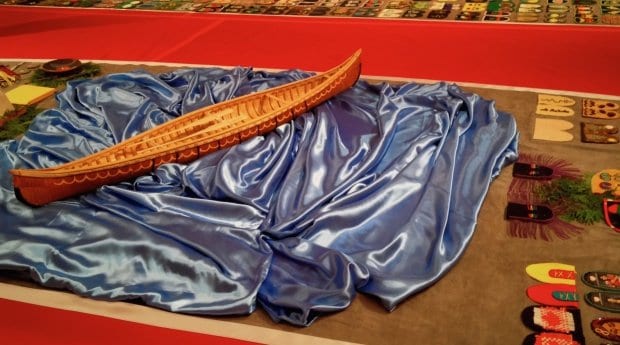Missing and murdered two-spirited people are being honoured at Walking With Our Sisters, an art exhibition that opened at the Carleton University Art Gallery on Sept 25, 2015.
Two-spirited is a term used by some Indigenous people in LGBT communities, according to Sharp Dopler, an outreach worker at the Ontario Aboriginal HIV/AIDS Strategy.

Walking With Our Sisters is a traveling art installation that commemorates the lives of more than 1,181 Indigenous women and girls who have gone missing or have been murdered in the past 30 years.
In Ottawa, a committee was created to make sure that two-spirited people were included in the exhibit.
However, Dopler says two-spirited is an “invented” term, and that not everybody in Indigenous communities embrace it. Dopler identifies as agokwe-nini, an Ojibway word that means “someone who is born in a female body but is more.”
The committee is trying to raise awareness that some women commemorated in the exhibit were two-spirited, says Kara Louttit, one of the project’s Ottawa organizers.
There are no statistics specific to missing or murdered two-spirited people, according to Louttit. She adds that both Indigenous and LGBT people experience poverty, addiction and mental illness at a greater scale than other communities.
“When you combine them I can only imagine that the numbers are greater,” she says.
Walking With Our Sisters is a collection of over 1,750 moccasin tops, called vamps, which were beaded and donated by over 1,350 artists. Because they are not sewn into the moccasins, the vamps represent the unfinished lives of the women.
The vamps, referred to by organizers as “the sisters,” are arranged on the floor so visitors can follow their path as they walk through the exhibit.
Louttit says some vamps were created specifically in memory of two-spirited women. One pair features a beaded image of the Golden Gate Bridge, and was donated by the Bay Area American Indian Two-Spirits.
Making specific reference to two-spirited people is important so they “remain in our thoughts and prayers,” says Melody McKiver, a two-spirited committee member and helper with the project.
According to Dopler, the ongoing process of colonialism in Canada has marginalized two-spirited identities. In many cases, violence toward two-spirited people began soon after contact with Europeans, she says.
“They were incredibly brutal once they kind of did the math and figured out what we were. And their response was to feed us to the dogs,” she says.
Gender non-conforming and trans youth were heavily persecuted in residential schools, according to McKiver.
McKiver says “gender-based protocols and policies” have become part of Indigenous ceremony in many communities since colonisation. The distinction between men’s and women’s roles has isolated some people.
At the Walking With Our Sisters opening ceremony on Sept 25, Louttit made a point of wearing a ribbon shirt, which is traditionally worn by men. Women traditionally wear skirts in Indigenous ceremony.
Louttit says she often felt guilty about not wearing a skirt, until she heard a two-spirited elder in Thunder Bay speak about the ribbon shirt. The elder said she wore a ribbon shirt so she could participate in ceremony as a two-spirited person.
“As soon as she said that, all of my feelings of guilt and shame were washed away, and I realized, you know what, I need to get a ribbon shirt,” Louttit says.
For McKiver, two-spirited organizing is about letting people have “determination over their own bodies.”
McKiver adds that she hopes people who visit the exhibit, which will be in Ottawa until Oct 16, will reflect on the two-spirited lives being honoured.


 Why you can trust Xtra
Why you can trust Xtra


